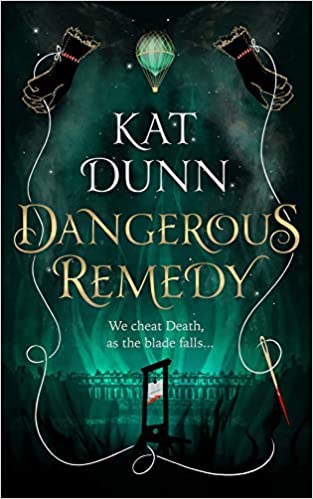Liz Bourke Reviews Dangerous Remedy by Kat Dunn
 Dangerous Remedy, Kat Dunn (Head of Zeus 978-1-78954-364-3, £12.99, 430pp, hc) August 2020.
Dangerous Remedy, Kat Dunn (Head of Zeus 978-1-78954-364-3, £12.99, 430pp, hc) August 2020.
Dangerous Remedy is a much-discussed debut novel from translator and podcast host Kat Dunn: I say much discussed, because I first heard of it in flattering terms as ”LGBT fantasy meets The Scarlet Pimpernel,” and I’ve heard much in its favour since. The advance praise may have had the effect of setting my expectations too high, because I didn’t enjoy it quite as much as I’d anticipated – but in this Year of Our Pandemic, I’m not at all sure whether the fault (as it were) is not in the work, but in myself, that I don’t have the capacity for whole-hearted enjoyment of caper-esque fun.
Dangerous Remedy sets itself in Paris in the middle of the French Revolution. The novel dates itself as Prairial, Year II (May-June 1794 in the Gregorian calendar) and reaches its culmination on June 8th, with the Festival of the Supreme Being. That puts it in the height of the Terror, after the execution of the Hébertists and the Dantonists and well after the Law of Suspects. (It sets itself, in fact, days before the intensification of executions post-June-10th that led to Robespierre’s overthrow.) The novel opens with a balloon-flight above the Conciergerie prison, part of a daring plan to facilitate an escape: the main characters are all part of a group, the Battalion of the Dead, dedicated to breaking individuals out of prison and saving them from the guillotine. This time, the person they’re trying to rescue is a young woman called Olympe, ostensibly the daughter of the duc de l’Aubespine.
Olympe isn’t an aristocrat’s daughter, though: instead, she’s a young woman with a mysterious and terrible ability to manipulate electricity, and as such, someone that all factions see as a potential weapon, or a potential threat. Handing her over to either royalists or representatives of the Committee of Public Safety, when it’s clear neither sees her as more than a tool, doesn’t sit well with her rescuers. But all the sides can bring pressure to bear which the small band of the Battalion of the Dead may not be able to resist. Twists and turns and capers – and unexpected betrayals – ensue.
There are only four members of the Battalion of the Dead. Camille, its leader, who has some sympathy for the revolution’s ends, but not for its methods – not since both her parents went to the guillotine. Ada, her lover, with a scientific turn of mind, who ran away from home in order to support Camille. Guillaume, an army deserter, and Al, an aristocrat with a price on his head whose family disowned him for his affairs with other men. Camille and Ada are the major characters, and the emotional centre of the novel is focused on their relationship: they might love each other, but their trust for each other is badly strained by the circumstances, especially when James, Camille’s never-mentioned fiancé, arrives from England.
There are a handful of issues with Dangerous Remedy that interfered with my ability to enjoy it fully. We can put most of them down to the cavilling of a thwarted historian, but at least one of them annoyed me badly: nobody notices accents. Something less than fifty percent of the people of France on the eve of the revolution natively spoke the same French as the king and his court. A majority of the population spoke patois such as Gascon, Provençal, Breton, Gallo, the Franconian dialects of Lorraine, or similar regional dialects. With one significant character from Marseilles and another showing up from England, in the suspicious atmosphere of Paris under the Terror, one would expect signifiers of class and origin to be marked. It bothers me, too, that there are only two factions apparent in 1794 France (the faction-riven revolutionaries had more central organisation than the scattered royalists, whose lack of cohesiveness helped doom the rising in the Vendée and in Brittany and Maine, but still) but for the sake of fiction such simplifications may be necessary. On an emotional level, my suspension of disbelief is impaired by the main characters’ lack of paranoia commensurate with the risks they take – or, in the absence of paranoia, their lack of resignation to their own deaths, because it becomes quite plain that both factions know very well who’s in the Battalion of the Dead.
I’m uneasy with rollicking capers set during periods of atrocity in real history, but Dangerous Remedy is definitely a rollicking caper with a dark edge. It’s fast and fun, and its central relationship is an interesting exploration of a committed queer relationship between two young women who value each other, but who have to negotiate what that means when they value other things potentially more than protecting each other.
I’m glad that there will be sequels, because whatever my cavils, I want to know what happens next.
Liz Bourke is a cranky queer person who reads books. She holds a Ph.D in Classics from Trinity College, Dublin. Her first book, Sleeping With Monsters, a collection of reviews and criticism, is out now from Aqueduct Press. Find her at her blog, her Patreon, or Twitter. She supports the work of the Irish Refugee Council and the Abortion Rights Campaign.
This review and more like it in the July 2020 issue of Locus.
 While you are here, please take a moment to support Locus with a one-time or recurring donation. We rely on reader donations to keep the magazine and site going, and would like to keep the site paywall free, but WE NEED YOUR FINANCIAL SUPPORT to continue quality coverage of the science fiction and fantasy field.
While you are here, please take a moment to support Locus with a one-time or recurring donation. We rely on reader donations to keep the magazine and site going, and would like to keep the site paywall free, but WE NEED YOUR FINANCIAL SUPPORT to continue quality coverage of the science fiction and fantasy field.







